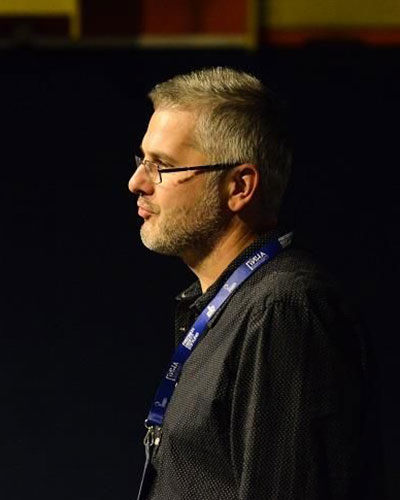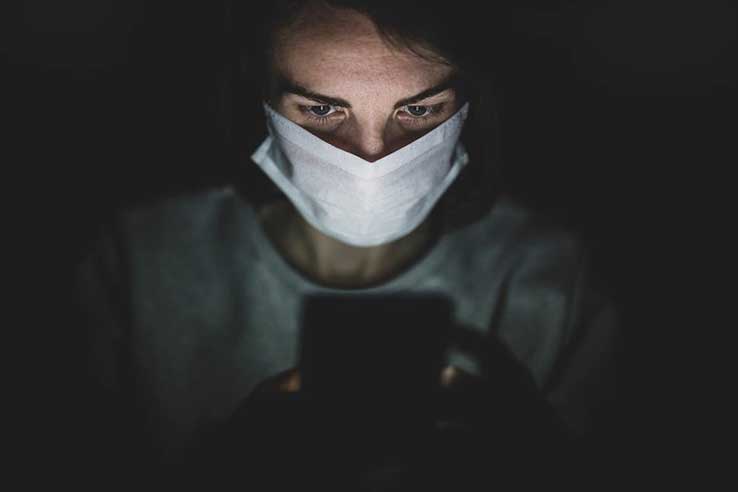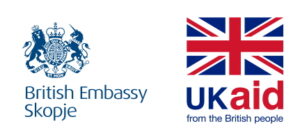Ivor Fuka
 Clearly, whichever way we slice it, we will be fighting fake news, misinformation, and conspiracy theories for a long time to come. Have we already mentioned that politicians are some of the biggest propagators of misinformation? Well, now we have!
Clearly, whichever way we slice it, we will be fighting fake news, misinformation, and conspiracy theories for a long time to come. Have we already mentioned that politicians are some of the biggest propagators of misinformation? Well, now we have!
That's right - a plandemic or plandemija in Croatian. That is the sign greeting the passengers at one of the busiest entrances to Zagreb. Those five syllables are written in black glossy spray-paint on five concrete blocks placed on the overpass above the city's major traffic route and it's really hard to miss it. The unknown author thus revealed a well-kept secret to those entering the city - the coronavirus pandemic that turned the whole world upside-down is a sham. Planned, of course, as indicated in the name p(l)andemic. I can't quite agree on whose plan it is, because there is a plethora of theories about it, but it is certain that everything that has happened before our eyes - is rigged. In any case, all this was "cooked up" for us by some very powerful people in order to imperceptibly rule over the planet. However, it is not that simple. Their estimate was flawed, not counting that there were those who would see through their infernal plan.
We don’t know if the world was already mad before all of this, but from last spring onwards, that diagnosis can be globally attributed with some certainty. The problem with this diagnosis could be that it is not clear which treatment could be effective. Since the outbreak of the pandemic, beg your pardon - plandemic, social media have been teeming with fake news and conspiracy theories, additionally giving rise to outpours of dangerous hate speech in Croatia. All those who do not see that it is a plandemic were called all sorts of names, as I believe all of you already know, for example, all those "stupid sheep" wearing masks are called "brnjičar" or myrmidion in loose translation.
Fact-checking to the rescue
An international survey titled Journalism and the Pandemic, which involved more than 1,400 journalists, confirmed that media workers encountered misinformation during the pandemic much more often than before, most of which came from Facebook, Twitter and WhatsApp. Specialized fact-checking portals have never had as much work as in the last year and a half. If there ever was any doubt, it is now perfectly clear that precisely such portals will play an increasingly important role in the future. That role comes along with threats and insults, as journalists who expose the inaccuracy of a particular false claim find themselves fiercely attacked by online bullies who send them threatening messages, usually with the adjective “mercenaries,” clearly because they participate in a global conspiracy of powerful people against the barehanded commonfolk.
This behaviour is disconcerting, because threats to journalists have become completely normalized in public arenas, as is the case with hate speech or public shaming. There are no journalists in Croatia who deal with fact-checking and who have not felt some of it on their backs. Although the media in Croatia in general did their job responsibly during the pandemic, those who deal with fact-checking go down rabbit holes or obscure Internet portals that have been springing up all over the world in recent years. These websites don’t employ journalists, but they present themselves as news portals and they spread fake news. The revenge against journalists who expose their fabrications is done by screening their private lives, ridiculing them, presenting them as homosexuals or some "undesirable" ethnic minority, publicly displaying their contact details and inciting their audiences to, for example, send as many messages as possible at a specific time and day. Thus, a bulls-eye is painted on their foreheads.
The only specialized fact-checking portal in Croatia, Faktograf, has in the past published over 400 articles exposing fake news and inaccurate claims solely linked to Covid-19 and vaccination. In total, these texts included more than 1,000 pieces of misinformation, most of which were posted on Facebook. Petar Vidov, the editor-in-chief of Faktograf, will describe the process.
"Given the large amount of misinformation going around, we focused on things that we assumed were incorrect and for the most part - it proved to be the case. It was important for us to counter as much of this misinformation as they appeared", said the editor of Faktograf, a portal that collaborates with Facebook as part of the Third Party Fact-Checking program, given that Facebook has taken additional measures against coronavirus misinformation since the beginning of the pandemic and it has been removing content that it deems to endanger public health. And health threats are a perfect depiction of the real social damage created by misinformation.
“People who believe in factual inaccuracies about Covid-19 are more prone to risky behaviour, making it harder to combat the epidemic and creating additional stress on the healthcare system. Those who believe in anti-vaccine propaganda and the harmfulness of the vaccine will not want to get vaccinated. Antivaxxers, who use social media to spread misinformation, spread fear and distrust of the vaccine among citizens, thus prolonging the duration of the epidemic. As long as there is a sufficient portion of people who refuse to get the vaccine, the virus has room to spread and further mutate. Any prolongation of the epidemic increases the number of human victims and puts additional strain on the economy", Vidov explained.
 Source: pexels.com
Source: pexels.com
Go vaccinate your mom - you ain’t jabbing me
There wasn’t much you couldn’t find: fake doctors and preachers, microchips and 5G technology, genocidal components in the vaccine, manipulated side effects of the vaccine, hidden poisons in protective masks, self-proclaimed coronavirus experts with huge numbers of followers, fake drugs and many other tales that we could list to the end of this article without going through them all. The mass spread of such things is made possible by people who make money by spreading fake news. Today, the Internet is full of portals that do not produce any copyrighted content, but only take content from other sources and try to present it as scandalous as possible or deprive it of context, in order to get as many visits and earn money through online advertising services. They use social media to spread the resulting "news" because it is a tool that can easily reach a large number of people.
Multiple anti-mask protests and protests against other epidemiological measures have been organized in Croatia, with the messages "Masks are for slaves" or "Stop dictatorship". Journalists have been attacked for poisoning the world with lies. Signs with the words "Corona is a scam" or “Go vaccinate your mother, you ain’t jabbing me" or "End corona-terror" were hung on busy city locations. The 6-kilometre-long promenade around Jarun Lake shows countless stencil graffiti messages about the "plandemic" or "shamedemic". Citizens found leaflets in their mailboxes and under windshield wipers, explaining to naive people that the coronavirus was a scam, a covert plan by a group of conspirators who are manipulating the situation to take advantage of it and turn people into their slaves. There have been several physical attacks on people who have warned someone to put on a mask indoors. People reacted in various ways during the lockdown, while the livelihoods of many people were on the line.
It’s hard to say what percentage of the citizens are convinced of at least some of all this misinformation and conspiracy theories that found their way onto the smorgasbord served last spring. There is no relevant and precise research on this. However, the impression is that, although it does not seem like it, it is a minority that is very loud and aggressive. That aggression is most visible, again, on social media. There, underneath any post linked to coronavirus that refers to scientific facts, there are a bunch of comments with vulgar insults spewed against "naive people" who believe in the plandemic and vaccinations, and those who engage in discussions with them then receive such insults in direct messages. They are declared either fools or accessories to a conspiracy.
Experts say conspiracy theories are fertile ground for many because they provide untrue, yet seemingly logical explanations for things that are harder for people to understand, thus providing some sort of a solution or a roadmap to win the fight, because when you understand things and know where the "danger" comes from, it's easier to go through such tumultuous times. And what these tumultuous times have produced, among other things, is an absolute increase in insensitivity and a complete lack of empathy. How else could we explain that under the posts shared by mainstream media on Facebook, saying that a person has died from coronavirus complications or under daily reports on the number of deaths in the last 24 hours, the most popular reaction is the laughing emoji, often used as a sign of ridicule? How else could we explain the huge number of likes from the beginning of the lockdown on a comment made by the then Member of Parliament Ivan Pernar, saying that it is not normal for the whole country to be paralyzed for months for some grandfather to be able to live a day, a week, a month or a year longer.
The story of the Croatian Headquarters
Although the same situation could be seen practically all over the world, in Croatia, the National Civil Protection Headquarters has significantly contributed to the general distrust in the institutions. It is an ad hoc established body that manages the coronavirus crisis in the country, formed only a few days before the first case of coronavirus infection was registered in Croatia. From the outset, there was reasonable doubt as to the legality of the body, as there was no legislation to provide the grounds to grant power to the Headquarters to manage this crisis. But that was the least of the problems.
Exactly three weeks after the first case of infection in Croatia, the Headquarters introduced significant epidemiological measures. First, schools and colleges switched to remote learning and immediately afterwards social gatherings were restricted, public transport stopped, and citizens were forbidden to leave their places of residence. A "lockdown" had started, during which, apart from grocery stores, almost nothing else worked. The daily press conferences of the Headquarters, always at the same time, were the most watched television program in Croatia in those days. In such conditions, the Headquarters made a series of decisions that were a complete miss and were epidemiologically unfounded, thus creating loss of public trust, which consequently, after the first wave of the pandemic, led to an increase in misinformation and conspiracy theories.
For instance, the Headquarters decided to exempt religious ceremonies from some of the restrictions. Thus, for example, a large traditional procession was allowed on the island of Hvar, and restrictions were eased before Easter, even a spokesman for the Episcopal Conference of Croatia attended one of the press conferences. Just as the Church has wanted for years, shops were temporarily closed on Sundays. When asked why on Sundays, we only got unconvincing answers. All this without any rational or epidemiologically justified reason and despite the words they kept repeating - "the next two weeks are crucial" - words that many Croats will surely remember for the rest of their lives.
Different game rules were allowed for the parliamentary elections in July, when the rules of self-isolation were changed, as well as during the attempts to save the tourist season as much as possible, so in those summer months the coronavirus became less important, even though the daily number of infected in those days it was twice as large as when the country was under complete lockdown. Funerals were forbidden for regular people, yet apparently there were no epidemiological risks for the burials of deceased politicians. Also, "plain folk" had to isolate themselves after coming into contact with an infected person, while in the case of some privileged people, these rules were relativized and adapted to the needs of the ruling party, for which distancing and mask-wearing measures did not apply after last July's election victory.
It should come as no surprise
At the same time, the members of the Headquarters repeatedly contradicted themselves on the matter of how effective protective masks are and where they should be worn. In addition, for each increase in the number of infected persons, they directly blamed the citizens, patronising and accusing them of indiscipline, and interpreting the problems as they saw fit at a given time. For example, when the Minister of Health, who normally spoke every day at the headquarters’ press conferences, was filmed in close contact with four people, while kissing the hand of a lady friend, this was not a problem. Or when the Chief of the Headquarters, who was also Deputy Prime Minister who claimed that he never shook hands because of a pandemic, was caught in a lie and photos were published. Croatian Prime Minister Andrej Plenković did the same thing. All this, you guessed it, was dismissed, but when it came to citizens, they would be called "bioterrorists" at the Headquarters press conferences. After all of that, there is really no room to ask how come some people don’t believe the "official truths". The Headquarters’ credibility melted away day by day, and a growing part of the public sought alternative explanations…
All these moves ran up a tab that had to be paid in part, and today the interest of citizens in vaccination has significantly waned, despite the fact that there are more than enough vaccines. Of course, various other factors contributed to this, after all, the "anti-vaxxer scene" in Croatia has been very active for two decades, but the behaviour of the ruling party during the pandemic certainly did not help. Despite the initial debacle, because vaccines arrived in Croatia very late, due to poor selection of vaccine packages in which most of the reserved doses were AstraZeneca, Croatia planned to completely vaccinate half of the adult population by July 1, 2021, primarily due to the tourist season.
This did not happen because only 31 percent of the adult population has been vaccinated with two doses of the vaccine as at a few days before that deadline. Only in the area of Zagreb did the Government achieve its goal - 51 percent of the adult population was vaccinated with two doses. Today, it also turns out that the authorities do not have an effective strategy to persuade the rest of the population to be vaccinated, just as institutions did not perform any meaningful public communication throughout the crisis and did not react when some public figures openly spread misinformation. They left that job to the media. But that is a topic for a completely different article.
Clearly, whichever way we slice it, we will be fighting fake news, misinformation, and conspiracy theories for a long time to come. And that is why it is important to work on media literacy of citizens, create a serious educational curriculum, so that we can distinguish solid sources of information from those that are not. But that is a policy matter. And have we already mentioned that politicians are some of the biggest propagators of misinformation? Well, now we have!
The text was created as part of the publication “Tales from the Region” conducted by the Macedonian Res Publica and Institute of Communication Studies, in cooperation with partners from Montenegro (PCNEN), Croatia (Lupiga), Kosovo (Sbunker), Serbia (Don’t Le Belgrade D(r)own), Bosnia and Herzegovina (Analiziraj.ba), and Greece (Macropolis), within the project "Connect the Dots: Improved Policies through Civic Participation" with the support of the British Embassy in Skopje.
Please refer to the Terms before commenting and republishing the content.
Note: The views and opinions expressed in this article are those of the author and do not necessarily reflect the views of the Institute of Communication Studies or the donor.


